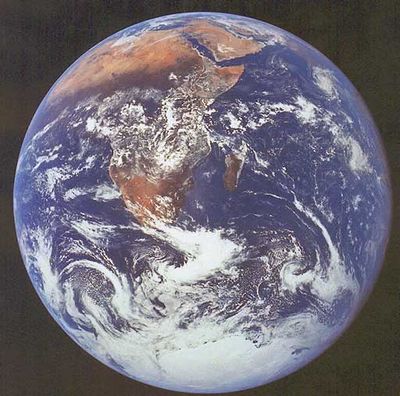The Blue Marble
The Blue Marble is a famous photograph of the Earth taken on December 7, 1972, by the crew of the Apollo 17 spacecraft at a distance of about Template:Convert.[1]
The name also has been applied by NASA to a modern series of image data sets covering the entire globe at relatively high resolution, created by carefully sifting through satellite captured sequences taken over time, to eliminate as much cloud cover as possible from the collated set of images.
The photograph
The snapshot taken by astronauts on December 7, 1972, is likely one of the most widely distributed photographic images in existence.[2] The image is one of the few to show a fully illuminated Earth, as the astronauts had the Sun behind them when they took the image. To the astronauts, Earth had the appearance of a glass marble (hence the name).
History
The photograph was taken on December 7, 1972, at 5:39 a.m. EST (10:39 UTC), about 5 hours and 6 minutes after launch,[3] and about 1 hour 54 minutes after the spacecraft left parking orbit around the Earth to begin its trajectory to the Moon. The time of Apollo 17's launch, 12:33 a.m. EST, meant that Africa was in daylight during the early hours of the spacecraft's flight. With the December solstice approaching, Antarctica also was illuminated.
The photograph's official designation is AS17-148-22727. (The photograph AS17-148-22726, taken just before and nearly identical to 22727, also is used as a full-Earth image.) The photographer used a 70-millimetre Hasselblad camera with an 80-millimetre lens.[4] NASA officially credits the image to the entire Apollo 17 crew–Eugene Cernan, Ronald Evans and Jack Schmitt–all of whom took photographic images during the mission with the on-board Hasselblad. After the mission, evidence showed that although the photograph could have been taken by any of the astronauts, Jack Schmitt probably took the famous image,[2] although the official photographer still cannot be verified completely.[5]
Apollo 17 was the last manned lunar mission. No humans since have been at a range where taking a whole-Earth photograph such as The Blue Marble would be possible.
The Blue Marble was the first clear image of an illuminated face of Earth. Released during a surge in environmental activism during the 1970s, the image was seen by many as a depiction of Earth's frailty, vulnerability, and isolation amid the expanse of space. NASA archivist Mike Gentry has speculated that The Blue Marble is the most widely distributed image in human history.[2]
The picture originally was taken with South at the top of the image, but was rotated before it was distributed.[6][7]
References
- ↑ Template:Cite web
- ↑ 2.0 2.1 2.2 Template:Cite web
- ↑ Template:Cite web
- ↑ Template:Cite book
- ↑ Apollo 17: The Blue Marble - InfoDabble
- ↑ Cite error: Invalid
<ref>tag; no text was provided for refs namedthousand - ↑ Cite error: Invalid
<ref>tag; no text was provided for refs namedtimeline

